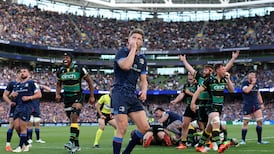Regional newspaper editors have said there is scant basis to a claim they had to treat paid-for Government content as if was “normal” copy indistinguishable from other news stories.
A large number of editors – representative of the sector – were contacted by The Irish Times and have spoken publicly and privately about the controversy.
All stated that the commercial features supplied by the Government to promote Project Ireland 2040 were branded as such in their newspapers, and were separate from their own independent reporting of the 20-year planning framework and 10-year development plan.
However, a number complained that the agency which represented the Government made several requests that had the potential to blur the boundary between editorial and so-called “advertorials”.
That included not describing the content as “advertising” and asking for the pages to be placed to the front of the newspaper, rather than towards the back.
"There was certainly some pushing of the boundaries but that is happening everywhere," said one source. "But to suggest it was a Pravda takeover and the Government was dictating the news, that was carrying it a bit far."
Partnership
The Irish Times examined the Government paid-for content in more than 20 regional titles yesterday. All had a strap across the top of their pages clearly stating the articles were "in partnership with the Government of Ireland", an indication that it was paid-for or commercial content. A minority, four in all, also stated it was "advertising", although others privately expressed discomfort that that distinguishing term had not been included in their papers.
The copy in most cases (with the exception of Independent News and Media titles) was supplied by the advertising agency Media Force and focused on local projects under the plans, as well as an overall generic piece on both projects. In all cases the main headline focused on the particular catchment of the title: "How the South West will Benefit" was the headline in the Southern Star.
In all but two of the newspapers, no names were mentioned or no interviews were conducted. The copy was essentially a synopsis of content from the plans. INM titles used articles by its own journalists, but the focus of the articles were projects, with no interviews conducted or politicians named.
In addition, besides a general shot of the Cabinet in Sligo, photographs of politicians appeared in only three publications – the rest of the publications featured pictures of buildings and projects earmarked for development.
Government sources said it supplied no photographs and issued no instructions on what photographs were to be used – that was left to the discretion of the titles. There was a photograph of a councillor, also a Fine Gael general election candidate, in the Longford Leader.
With the migration to digital platforms, there is growing commercial pressure on media organisations in recent years to retain advertising. The growth of “native advertising” (commercial copy presented similarly to editorial content) has become a new phenomenon in the industry.
Con Downing, editor of the Southern Star, was one of those who insisted the word 'advertising' was included. It played into a larger concern he had.
“There is a bigger principle at play about native content. It’s beginning to creep in into publications and I would not be in favour of it. I wanted to make that clear.”
Other editors said the strapline at the top of the page and the headline “in partnership with the Government of Ireland” distinguished the copy from editorial copy carried elsewhere.
Critical coverage
The 22 newspapers carried extensive coverage of the plans, some of it highly critical. The Clare Champion reported the mixed reaction it received; the Carlow Nationalist reported a clash between Fine Gael and Fianna Fáil over its benefits to Co Carlow; while the Midland Tribune reported councillors' fears for rural Ireland.
Austin Hobbs, editor of the Clare Champion said: "It did not impact or impinge on our own [independent] reporting of it. We had stories that reflected negative reaction to it.
“It was not suggested to us at any stage that we had to treat [the paid-for content] as if it was part of our coverage. It was clearly separated from that.”
David Burke, editor of the Tuam Herald, said the strap-line made it very clear it was paid-for content. He also pointed out that the report appeared in the back end of the paper.
“We had our own coverage much earlier in the paper. We had an editorial as well.
“That line ‘in partnership with Government of Ireland’ was making it very clear to our readers that it was paid-for content,” he said.
Initially, the advertising agency had requested that newspapers not brand the copy as “advertising” and also that they use the media organisation’s own logo alongside the Government logo.
But editors said there was no resistance when they diverted from that format. Michael Duffy, editor of the Mayo News, said he ended up running the Government logo "but not our own".
“We also changed a few headlines, they were subtle but important changes. We designed the two pages differently from our own pages and made it obvious it was commercial.”
So-called advertorials have been an intrinsic part of newspapers for over half a century. Several of the regional editors argued that their paid-for content was more identifiable than it was in several of the national newspapers.















